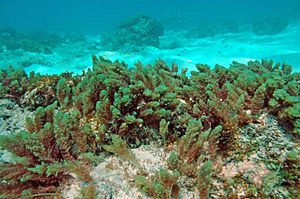Asparagopsis facts for kids
Quick facts for kids Asparagopsis |
|
|---|---|
 |
|
| Asparagopsis taxiformis in Mayotte. | |
| Scientific classification |
|
| (unranked): | Archaeplastida |
| Division: | Rhodophyta |
| Class: | Florideophyceae |
| Order: | Bonnemaisoniales |
| Family: | Bonnemaisoniaceae |
| Genus: | Asparagopsis Mont. |
Asparagopsis is a type of red algae that you can eat. It's a plant that grows in the ocean, so don't mix it up with the vegetable called asparagus! There are different kinds of Asparagopsis. One kind, Asparagopsis armata, lives in cooler waters. Another, Asparagopsis taxiformis, prefers warm, sunny places like tropical oceans.
Helping the Planet with Seaweed
Asparagopsis seaweed has a special power! It contains a natural substance called bromoform. This substance can stop animals like cows from making too much methane gas. Methane is a strong greenhouse gas that contributes to climate change.
Cows and other animals like sheep are called ruminants. They have a special stomach that helps them digest grass. But during this process, they release methane gas when they burp.
Because Asparagopsis has a lot of bromoform, it's really good at stopping methane production. Scientists have done experiments where adding a little bit of this seaweed to animal feed reduced methane by a lot, sometimes up to 99%! This is why some companies are now growing Asparagopsis to use as a special food additive for farm animals.
In Australia, a big study was done by groups like Meat and Livestock Australia, CSIRO, and James Cook University. They found that if Asparagopsis made up just 3% of a cow's food, it could cut methane emissions by 80%. This shows how helpful this seaweed can be for our planet.
Award-Winning Research
In 2020, a special food supplement called FutureFeed won a big award called the Food Planet Prize, worth $1 million. This supplement is made from Asparagopsis. The prize recognized how important this product is because it helps reduce the powerful greenhouse gases that cattle produce.
The winners of the prize said they would use the money to create a fund. This fund will help First Nations communities around the world. It will give them a way to earn money by growing and selling this special seaweed.
Images for kids



